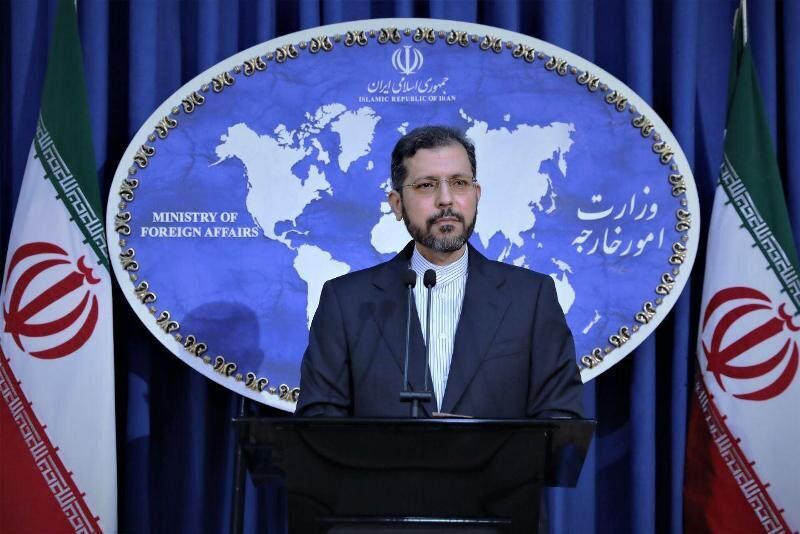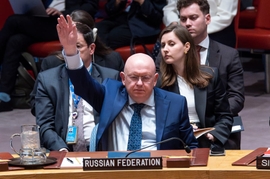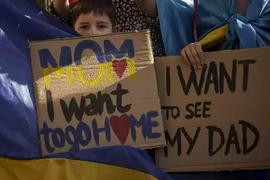People in the northern provinces of Iran have taken to the streets to show support for Azerbaijan and demand the closure of the country’s border with Armenia amid reports of Russian military equipment being transferred via its borders to Yerevan.
A large number of Azerbaijanis, who make up a sizable percentage of Iran's population, have staged rallies in the cities of Tabriz, Urmiya, Ardabil, Meshginshahr, Tehran, Parsabad-e Moghan and Zanjan, expressing their support for Azerbaijan in the wake of Armenian attacks. The Iranian authorities arrested at least 12 pro-Azerbaijan protesters in the northeastern city of Ardabil, the Iranian Human Rights Activists News Agency reported on October 1.
Azerbaijanis constitute at least one-third of Iran’s 81.8 million population - about 30 million - according to Unrepresented Nations and Peoples Organization's (UNPO) 2017 data. Meanwhile, Iran has an Armenian community of just under 100,000.
Some news and social media reports claim that Iranian authorities have traditionally taken a pro-Armenian approach in the Nagorno-Karabakh conflict, and say that Iran has opened its airspace, and its territory to facilitate the transport of military equipment and weaponry to Armenia through Iran's Norduz border point, as well as supplying fuel to the Armenian forces in the occupied Nagorno-Karabakh region of Azerbaijan.
“Armenia, in return, allows the transportation through its territory of supplies for the Iranian nuclear and missile programs,” according to the research organization The Greater Middle East.
However, Iranian authorities have rejected such claims. On September 29, Iranian Foreign Ministry Spokesman Saeed Khatibzadeh denied media reports suggesting that weaponry and military hardware are being transported to Armenia amid an escalating battle between Armenian and Azerbaijani forces.
“The Islamic Republic of Iran carefully monitors and controls the route of transportation and transit of commodities to other countries [via its soil] and does not allow our country’s soil to be used for the transfer of arms and ammunition whatsoever,” Khatibzadeh said on September 29, referring to a statement posted on the official website of the Iranian foreign ministry.
He said the transit of conventional non-military items through Iran to neighboring countries has always been underway, adding that “the mentioned trucks are crossing Iran simply within the same framework."
During a phone conversation with Deputy Prime Minister of Azerbaijan Shahin Mustafayev on September 30, the Iranian President’s Chief of Staff Mahmoud Vaezi dismissed rumors that Iran has supported Armenia in the ongoing military conflict.
Vaezi underlined Iran’s respect for Azerbaijan’s territorial integrity, and said that “such rumors are totally baseless and aimed at upsetting the good relations between Iran and Azerbaijan."
He also expressed concern about the armed clashes between Armenian and Azerbaijani forces, and said that Tehran is closely monitoring the developments, adding that the government is ready to help in finding a solution to the conflict through dialogue within the framework of international law.
On September 30, Iranian state-owned TV IRIB news confirmed social media footage of brand new Kamaz trucks crossing borders into Armenia, saying the latter had bought them from Russia. However, in their interviews with the TV, the drivers in Norduz border point denied their lorries were loaded with weapons and ammunition.
The drivers also said that a total of 670 lorries will be delivered to Armenia, and 600 of them have still not departed Iran’s Anzali port that located on the southern shores of the Caspian Sea.
Baku had earlier voiced concerns about reports of large arms shipments transferred from Russia to Armenia during and after the fighting in Azerbaijan’s north-eastern region of Tovuz near the border on July 12-16.
On September 7, the Iranian Embassy in Baku refuted reports circulated by Azerbaijani media suggesting that Russian weapons and military equipment bound for Armenia were delivered through Iran’s Norduz border point in the country’s East Azerbaijan province.
The Meghri-Norduz border crossing point is the only land border between Armenia and Iran. There are Free Economic Zones operating on both sides.
Azerbaijan also uncovered regular flights of military cargo from Russia to Armenia, that were forced to make a detour on their way to Armenia after Georgia refused to give them permission to use its airspace between July 17 and August 6. Heavy cargo-carrying aircrafts were forced to take a much longer route stretching from Russia to Kazakhstan, Turkmenistan and Iran.
In August, Azerbaijani President Ilham Aliyev discussed reports about the delivery of large amounts of military supplies from Russia to Armenia amid the outbreak of fighting between Azerbaijan and Armenia in the mid-July.
Clashes between Armenian and Azerbaijani forces erupted on September 27 after Armenia's forces deployed in the occupied Azerbaijani lands started shelling the military and civilian positions of Azerbaijan. Currently, combat operations are being conducted along the Line of Contact in the occupied Azerbaijani lands, marking the most intense fighting between Armenian and Azerbaijani forces since a ceasefire agreed in 1994.
The occupation of Azerbaijan's Nagorno-Karabakh region and seven surrounding districts by Armenia came after both nations gained independence following the Soviet Union’s dissolution in 1991. Armenia launched military campaign against Azerbaijan with the aim of occupying the Nagorno-Karabakh region. A large-scale war between the two countries lasted until a ceasefire deal was reached in 1994. As a result of the bloody war, Armenia occupied 20 percent of Azerbaijan’s internationally recognized territories – the Nagorno-Karabakh region and seven surrounding districts, including Lachin, Kalbajar, Aghdam, Fuzuli, Jabrayil, Gubadli, and Zangilan. Azerbaijan faced a humanitarian crisis during the war, in which 30,000 of its citizens were killed, while one million others were forcibly displaced from their homeland.
Although the United Nations Security Council adopted four resolutions demanding the immediate withdrawal of the occupying forces from Azerbaijani lands and the return of internally displaced Azerbaijanis to their ancestral lands, Armenia has failed to comply with all four legally binding documents.







 President Ilham Aliyev shed light on the evolving contours of the peace process with Armenia during an international conference in Baku this week. ...
President Ilham Aliyev shed light on the evolving contours of the peace process with Armenia during an international conference in Baku this week. ...
 Azerbaijan and Armenia started the process of demarcation of their border on Tuesday, with the installation of the first border markers based on ge...
Azerbaijan and Armenia started the process of demarcation of their border on Tuesday, with the installation of the first border markers based on ge...
 President Aliyev emphasized the critical role of the North-South Transport Corridor in fostering transport cooperation between Azerbaijan and Russi...
President Aliyev emphasized the critical role of the North-South Transport Corridor in fostering transport cooperation between Azerbaijan and Russi...
 Iran and Pakistan have signed eight cooperation documents in various fields, and agreed to strengthen ties to fight terrorism in the region.
Iran and Pakistan have signed eight cooperation documents in various fields, and agreed to strengthen ties to fight terrorism in the region.
 As the conflict between Ukraine and Russia escalates, the strategic importance of Kharkiv, Ukraine's second-largest city, has come sharply into focus.
As the conflict between Ukraine and Russia escalates, the strategic importance of Kharkiv, Ukraine's second-largest city, has come sharply into focus.



